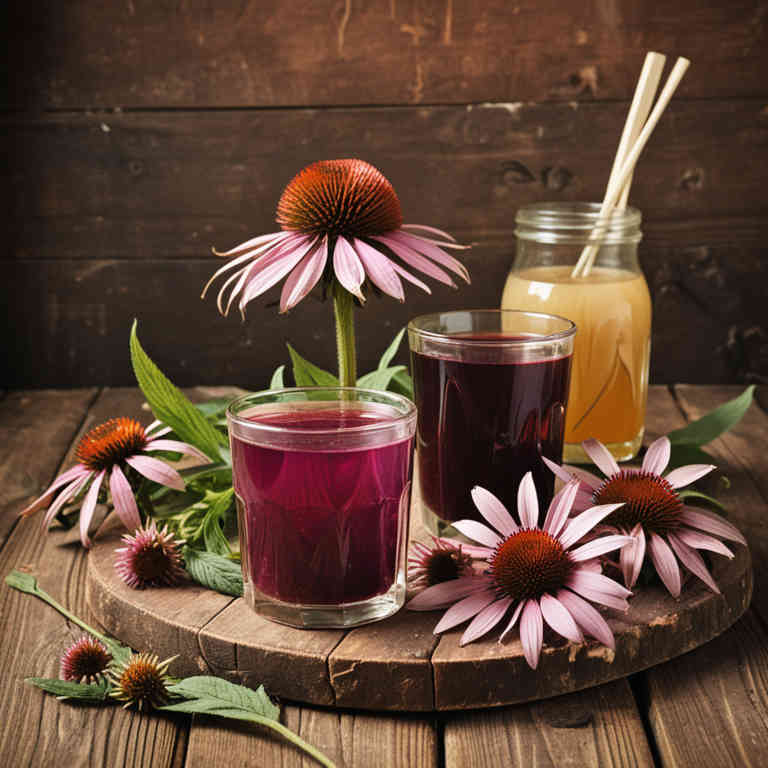Echinacea purpurea juice for medicinal use

Echinacea purpurea juice is a concentrated liquid extracted from the fresh or dried parts of the echinacea plant, primarily from its leaves and flowers.
It is commonly used in herbalism to support the immune system and is believed to help reduce the duration and severity of colds and flu. The juice is often prepared by macerating the plant material in water or alcohol to release its active compounds. It is typically consumed in small doses, either directly or diluted in water, to harness its purported anti-inflammatory and antimicrobial properties.
In traditional herbal practices, it is valued for its potential to enhance the body's natural defenses against infections.
Uses
Echinacea purpurea juice has been used to support immune function and treat respiratory infections for centuries, particularly by Indigenous peoples of North America who traditionally used the plant for its healing properties.
Historically, it was employed to reduce fever, alleviate cold symptoms, and promote wound healing, often prepared as a tea or tincture. In modern times, echinacea juice is commonly used as a natural remedy to shorten the duration of colds and flu, with some studies suggesting it may boost the immune system. It is also found in various over-the-counter supplements and topical products for its anti-inflammatory and antimicrobial properties.
Despite its popularity, the effectiveness of echinacea juice can vary, and it is generally considered safe when used as directed.
Benefits
Echinacea purpurea juice has health benefits such as boosting the immune system and reducing the duration of colds.
It is known for its anti-inflammatory and antioxidant properties, which may help fight infections and support overall immune function. The juice contains compounds like alkamides, caffeic acid derivatives, and polysaccharides that contribute to its medicinal effects. Some studies suggest it may help alleviate symptoms of respiratory infections and enhance the body's natural defenses.
However, it is important to consult a healthcare professional before using it, especially for individuals with allergies or chronic conditions.
Constituents
Echinacea purpurea juice active constituents include alkamides, caffeic acid derivatives, and polysaccharides, which are believed to contribute to its immune-modulating properties.
Alkamides interact with the immune system to enhance its response to infections, while caffeic acid derivatives exhibit antioxidant and anti-inflammatory effects. Polysaccharides may stimulate the production of white blood cells, supporting the body's defense mechanisms. These compounds work synergistically to promote overall immune health and reduce the severity of colds and respiratory infections.
Echinacea purpurea juice is commonly used as a natural remedy to support the body's ability to fight off viral and bacterial pathogens.
Preparation
To make Echinacea purpurea juice, start by selecting fresh or dried Echinacea purpurea leaves and flowers.
Wash the plant material thoroughly and chop it into small pieces to facilitate extraction. Place the chopped Echinacea in a blender with a small amount of water and blend until it becomes a pulp. Strain the mixture through a fine mesh or cheesecloth to separate the liquid from the pulp.
Finally, press the strained pulp gently to extract as much juice as possible, and store the juice in a clean, airtight container in the refrigerator.
Side Effects
Echinacea purpurea juice may lead to gastrointestinal discomfort, allergic reactions, and interactions with certain medications.
It is derived from the purple coneflower and is commonly used to support immune function. Some individuals may experience nausea, vomiting, or diarrhea when consuming it. People with allergies to plants in the daisy family may have adverse reactions.
It is important to consult a healthcare provider before using echinacea, especially for those with chronic conditions or taking other medications.